Passing parked cars is a relatively common driving test failure. The reason being that a learner driver may not effectively forward plan, is unable to predict a possible situation occurring or does not correctly judge a situation they are currently in.
Driving tests usually always involve taking a wide variety of road types. Many of these can often be residential streets that have parked cars on either one or both sides of the road. Driving examiners take these roads for among other things, to see how you deal with passing parked cars and meeting oncoming vehicles.
This tutorial explains the correct distance for passing parked cars along with the correct approach and when you should give-way to other vehicles.
The key to resolving a hazardous driving situation is thinking distance – the time it takes for a driver to react to a situation. Many learners fail tests not because they’re going too fast in legal terms, but because they don’t give themselves enough time to think. If the road ahead looks hazardous, ease off the gas, observe and think.
Passing parked cars right of way
Although passing parked cars rules vary depending on the situation, generally who has right of way is detailed by the diagrams below. Let’s assume for the scenarios below, you are the driver of the red car.
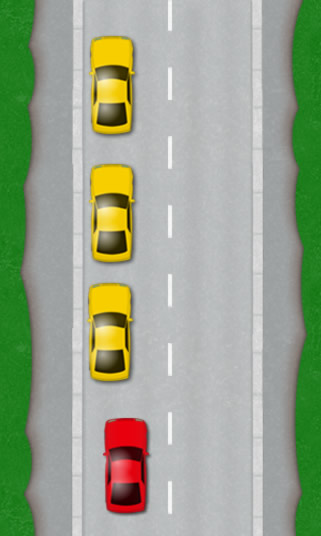
Parked cars on the left
Passing the yellow parked cars on the left, the red car does not have right of way due to the necessity of crossing onto the opposite side of the road in order to clear the parked cars. The red car will need to wait behind the yellow cars to give way to oncoming vehicles.
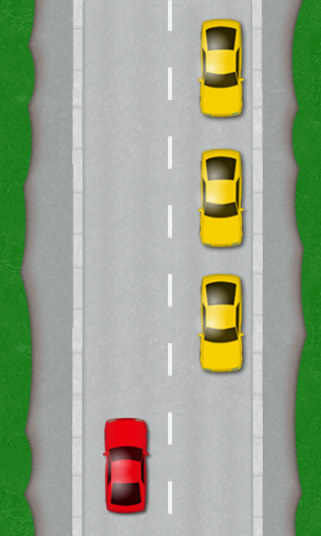
Parked cars on the right
Passing the yellow parked cars on the right, the red car has right of way. Vehicles traveling in the opposite direction will need to wait behind the yellow cars until it is clear for them to cross onto the opposite side of the road.
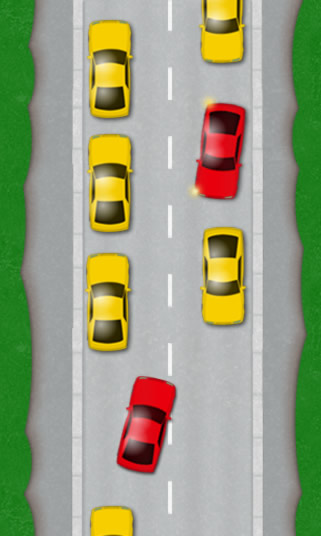
Parked cars both sides
Vehicles parked on both sides of the road represented by the yellow cars, nobody has right of way. Either driver of the red cars will need to find a suitable gap to pull into to allow the other vehicle to continue.
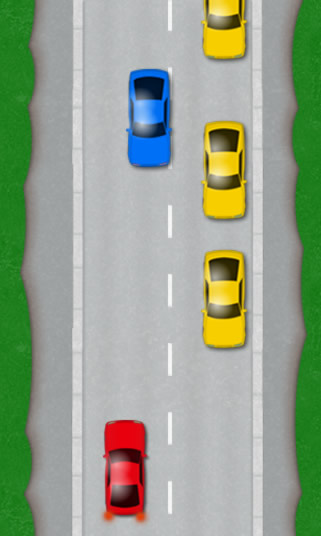
Giving way if you have right of way
As the driver of the red car with the yellow parked cars on the opposite side of the road, you have right of way. However, if an oncoming vehicle has already committed to the overtaking procedure whilst you are approaching, you should give way. It’s essential during a driving test that you look well ahead whilst before and whilst passing parked cars for this type of situation and be prepared to give way even if it’s your right of way.
If a situation such as this occurs during a driving test and you did not give way, either you or the other vehicle will need to manoeuvre out of the way. If there are no gaps within the parked cars for the blue car to enter, it may require one you needing to reverse to a point in the road where you can pass. This situation certainly isn’t ideal during a driving test and mounting the pavement to allow a vehicle to pass will certainly fail a test.
The key is to observe the parked cars well before you reach them, gently slow the car and look well ahead for oncoming vehicles. Whilst passing the parked cars, look out for gaps in the within the cars that are large enough for an oncoming vehicle to pull into. If the road is narrow, be prepared to stop and wait for the oncoming car to pull into the gap and allow you to proceed.
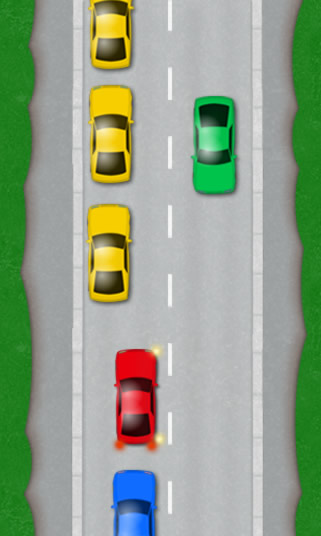
Signal when passing parked cars
Generally it is unnecessary to signal when passing parked cars. Excessive signalling in this situation can potentially be confusing to other drivers as they may think you are making a right turn.
There are however situations where a signal may be of benefit to other vehicles. As illustrated in the diagram, the red car is approaching yellow parked cars on the left so will need to give way for the green car. The road is narrow, so when you stop to give way, your road position will not be too dissimilar to that of the parked cars. A signal to the right on this occasion will provide the driver of the vehicle behind you with your intention to continue round to the right, passed the parked cars and that you have simply not parked behind the other parked cars.
Any situation that a signal will eliminate any possible confusion is necessary. It’s not always parked cars of course. Any object on your side of the road that requires you give way to oncoming vehicles may require a signal if there is a vehicle driving behind you and you believe the object may be difficult for the vehicle behind you to see. This could be small road-works for example. Again, this will make your intentions clear to the driver behind.
Gaps in parked cars
If passing parked cars on your side of the road, always look well ahead for approaching traffic that you may need to give way to. You’ll need to plan ahead an use these gaps to pull into if necessary. And remember, as mentioned above, you may need to also observe gaps in parked cars on the opposite side of the road. Though you have right of way, if you road is narrow, you may need to stop to allow for an oncoming vehicle to pull into a gap.
Extra caution when passing parked cars
Passing parked cars round bends, on hills and dips in the road represent a significant increase in danger due to the inability to see oncoming vehicles until very late. You also need to be aware that if there is an oncoming motorist, they may be unaware of the parked cars you are passing, which may result in them not reducing their speed.
Although the same rules apply as above, a further reduction in speed is often necessary due to the increased danger. Remain vigilant of any approaching vehicle and prepare to react swiftly by slowing, stopping or moving into any gaps within the parked cars. Take care to also keep check of following traffic behind you. They will of course need to react as quickly as you. If a vehicle behind is following very closely, an even further reduction in speed may be necessary to accommodate a greater reaction time for the driver to safely stop behind you.
Passing parked cars clearance
Whilst passing parked cars on a road with good clearance from both the parked cars and the right hand side of the road, provide 1 metre clearance from the parked cars. In the event a car door should open from one of the parked vehicles, 1 metre clearance should eliminate a potential accident.
Passing parked cars and your speed
If passing parked cars on a narrow road for example, it isn’t always possible to leave a 1 metre clearance gap. Appropriate speed now becomes significant. The speed at which you drive in this situation depends on the passing clearance available from the parked cars and your ability to spot any hazards ahead such as approaching vehicles. Even in a 30 mph zone, on a narrow, bendy road whilst passing parked cars, it may be necessary to drive significantly slower than the speed limit.
The blind spot
If you are giving way behind a parked car whilst waiting for an oncoming car to pass, before moving off it may be necessary to take a quick glance into the side mirrors and possibly the blind spots if in an area with many cyclists.

My wife crossed the road and opened her door nine inches the on coming car hit the seam of the door and shunted the car and nearly crushed her legs I got it on video any lawyers interested taking this case on because the lnsurance company’s are giving us the runaround so much for the 1 meter clearance
How to judge from left side mirror and space between park car .
I don’t think there’s really a reference point for that one Sachin – just good old practice.
At first I was confused because this all didn’t make sense this must be in Europe because in the United States it’s opposite since we drive on the other side of the road
Yes, this is a UK based tutorial site 🙂
Do these rules apply when on a hill, is there no right of way for cars coming up hill, when car are parked on both sides?
Hello Rachael
The Highway Code does reference that it is advisable to give way to vehicles coming uphill on a single track road, even if it requires the driver descending the hill to reverse. A driver will generally have greater control of the vehicle when reversing uphill (the engine is controlling the speed and you have gravity to help you stop). Reversing downhill is easier to lose control and gain too much speed, plus the vehicle is reliant a lot more on the brakes only. It is worth noting however that this is general advise and it is not a driving regulation.
I was turning from road into side road. A parked car was on the left side of the road I was turning into. Another car was next to parked car coming from direction I was turning into. He had no indication and was not moving. He was in middle of road and it was blind corner I was turning into. Consequently I hit him but I was on my side of road and he was in middle. He is blaming me but couldn’t see him. I was travelling about 15 miles per hour
Hi today I failed my test as when proceeding on a road there was a lorry coming in the opposite direction however on my side there were cars parked causing the road to be very tight. There were also cars behind me. As the lorry was slowly coming forward I was also moving forward very slowly but due to the tightness the examiner pulled the steering wheel slightly near him. My question is if I had stopped instead and allowed the lorry to proceed which he was doing already would I have failed( as I’m stopping causing cars behind me to stop) or would that have been allowed or would that have made no difference as my car was still close to his [which i am assuming as he didnt break but just moved the wheel] ?
Thanks
Hello lels,
It’s really difficult to say without seeing it because there are so many varied situations on a test. Firstly, I assume you didn’t give way to the lorry before attempting to pass the parked cars because you had already committed to the manoeuvre when the lorry approached (that would have been the ideal situation). If you could have done that, but didn’t, that would have been why you failed.
The next ideal situation, based on the room being very tight would have been to find widest possible section of road in the time you had (this could be where a smaller parked car is for example), pull in close to the car and stop there to allow the lorry a little more room. As soon as the lorry has passed, move off. It doesn’t matter that there were cars behind you, in tight situations such as this, they have to respond to what the vehicle in front of them is doing.
Situations like this happen all the time on roads and each situation may require a different action. For example, the oncoming vehicle that has priority might have to stop at a wider section of the road to allow the cars that don’t have priority to filter through before proceeding. Examiners specifically choose roads like this to see how you deal with making quick and safe decisions. Did the examiner not provide an explanation?
Question form a cyclist – I regularly cycle along a road where there are parked cars on both side of the road. I can pass these parked cars and remain on my side of the road. Car drivers need to cross on to the other side of the road. Cars coming towards me think they always have priority (because they are in a car!) but I believe that I have priority as I am not crossing out of my lane (which they have to do) – who has right of way?
Hello Douglas,
Much of the Highway Code is advisory, this includes crossing broken white lines in the centre of the road. As there’s no regulation attached to it, much of it comes down to common sense and being courteous. Drivers and cyclists who insist on pushing through because they ‘have priority’ can often cause more problems in these situations. Having said that, if you were both already committed, then it would be the car driver who should make way for you being as you’re on your side of the road.
The 1 metre clearance is advisory if she opened the door into another car its her fault she shouldn’t of waited for a clear gap.
While accurate in terms of how people should conduct themselves… this artice is incorrect in it’s wording.
There is no such thing as the ‘right of way’ for drivers/riders on Britain’s roads.
The overview for rules 103-158 explicitly says:
“The rules in The Highway Code do not give you the right of way in any circumstance, but they advise you when you should give way to others. Always give way if it can help to avoid an incident.”
Laura,
Most of the Highway Code is in fact advisory. You’ll note that in the Highway Code the use of the word ‘should’ and ‘must’. You might also note that the word ‘should’ is used here. In general, learner drivers need specific instructions as a foundation point. Telling a learner at the start ‘you don’t need to give way to anyone’ would likely be very confusing.
Hi, I am very confused in the Highway Code it reads once you have made your move and you are overtaking parked cars (that are on the same side) you have right of way. My wife was overtaking 4 parked cars she was just about to pass the last parked car when the oncoming car hit our car. When I pointed this out to my insurance they told me the Highway Code is just a guideline and it was my wife’s fault. Is this right? Cheers
Hi Scott,
Yes, they are correct. Much of the Highway Code is recommended guidelines. It’s difficult to form an opinion based on what you say without specific details, but once a driver has committed to overtaking parked cars which results in them driving on the opposite side of the road, most sensible oncoming drivers would give way and allow them to pass. There are some drivers that simply see it as their right of way and will push on ahead regardless of consequences. BUT, you can never assume what another driver should do (in an ideal world) and your wife should have been prepared to stop or pull into a gap between the parked cars if one was available.
What happens if there are no white lines in the middle of the road? Because I’ve noticed that when there are parked cars the white line is not down the middle so how do they know if you have crossed it? Cheers
All dashed white lines do is indicate the centre of the road. They don’t have any status in law. Solid white lines on the other hand are a very different matter.
There were no white lines in the middle of the road so how can they determine that my wife had crossed them?
I don’t know Scott, this would be something you’d need to ask her insurance company. But I would assume that as she was passing parked cars at the time, she would have therefore been more likely to be on the opposite side of the road to some extent.
Hi, I am going to be applying to take the D1 minibus pcv driving test in the future. Regards the parked cars, since the vehicle is larger. If you are driving on a road, with both sides parked vehicles, and it is narrow, should you totally stop, or go much slower has stated? If there is a long road of parked cars you may never get moving if traffics bad in both directions.
Im wanting to know tips for this to give me best chance to pass the test. Many thanks. 🙂
Hi Wayne,
It’s difficult to say really as each situation is different. I would never recommend totally stopping unless there’s a specific reason to such as you need to give way to an oncoming vehicle. In these situations I generally recommend going slowly and always looking well ahead for any gaps to pull into. Anticipate and planning is essential.
what is the rule on right of way if you are passing parked cars which have narrowed the road to single file only – no white lines present at all – is there a rule as to who should give way to who or is there no specific rule ( uphill or down hill) those whose side the cars are parked on giving way to those who don’t have obstruction ( even though no central lines )
Hi Neil,
No, there’s no specific Road Traffic Act rule. It’s more of a courtesy thing really. Generally speaking, drivers who have the parked cars on their side of the road give way to oncoming traffic. If there’s cars parked on both sides of the road, no one has priority.
In reply to Richard Hanley.
It’s your wife’s responsibility to check it’s safe BEFORE opening her door. She hit the oncoming car. The car did not hit her. The Insurance company knows who is at fault hence why your getting nowhere. She caused the accident and unfortunately got injured in the process. She is also liable for the repairs to the car she hit. Your wife must be the size of a 4 year old child and as flexible as a gymnast if she can squeeze her body into a 9 inch gap. Your story just doesn’t add up!
In reply to June Dodsley.
When you turn into any road you must give way to whatever is already in that road regardless of where on the road the vehicle/pedestrian etc is.
In reply to June Dodsley
Yeah I think a) too many cars per house, each house by me has 3 to 5 cars meaning driving and parking is a pain for pedestrians and other cars b) a car shouldnt just stop in the middle of the road not moving blocking the road that’s his fault and causing issues c) too many cars park right by or opposite a junction which the Highway code says they shouldnt do but they do. Learner drivers find this extra stress on a test as so many things to think about, my dad always said you learn to drive after your test. I agree it should be generally give and take being courteous and going slow pulling in and giving way when needed, but often its just too many cars not enough parking
ok i was in a dead end street at the bottom there is a turning around point so ive turned around and there are 15 parked cars on my side .i can see the road is clear right up to the junction there are no white lines untill you get to the junction there are no safe gaps in the parked cars.so im passing the cars when another car turned into the lane and was oncoming and at this point im half way passed the cars who has the right of way. as they kept oncoming and caused an accident by clipping my mirror by the way my insurance dont agree they are at fault
Hi Martin,
Generally speaking, they would have had right of way due to the cars being parked on your side of the road. Though obviously it would have made far more sense if they had waited for you to clear the road before proceeding. There are some rather odd drivers who take what they perceive as ‘their’ priority over safety. Having said that, much of the Highway Code is advice and not law and in terms of insurance, many incidents that occur on our roads work out the way we expect them to. In these situations, it’s often best to have video evidence that regardless of priority, a driver didn’t act in a safe manner expected of the situation. This may then supersede the issue of priority.
If you have a road with traffic lights at a cross roads and there are parked cars either side of the road and you see that the cars on your side could potentially block oncoming vehicles. Lights are on red at this point . Do you stop completely ( longish road) at the start of the parked cars and wait for the cars to come down road or go slowly allowing either car to pull into gaps?
Hi Angie,
Being as there are cars parked on both sides, then nobody has priority. If the other cars have already committed and are making their way down the road and you have yet to start passing the parked cars, I would generally say that it’s a little more courteous to wait. However, if it is a long road and the other vehicle are a distance away and you can see that they have gaps to pull into, it’s equally okay to proceed and when you come to a gap (either their side or yours) wait for them to pass. But you do need to ensure there are gaps that at least someone can get into (whether you or them), because the last thing you want is the inability to pass and for someone having to reverse a distance.
It should probably be handled no differently than a one-lane bridge type of a situation if there isn’t room for both to pass, especially if the lanes aren’t marked.
Hi C,
Yes, that’s a good way of thinking about it. There’s a general ‘rule’ of priority, but best not to assume that it’s going to always work that way.
Is the passing of parked cars and giving way to oncoming traffic actually covered in the Highway Code? If so, which Rule is it?
Hi Trevor,
Rule 163 of the Highway Code states: Give way to oncoming vehicles before passing parked vehicles or other obstructions on your side of the road.
But, much of the Highway Code is guidance, backed up by some rules. When it comes to passing parked cars and teaching this process, it’s more about common sense and general road etiquette, rather than actual rules and regulations.
With parked cars on both sides of the road, do you give way to oncoming traffic if there is a lorry on your left as the traffic on the other side only has cars?
Hi Ray,
Yes, you still give way regardless of what vehicles are parked. Sometimes parked vehicles, especially large vehicles means that on busier roads, drivers might have to take turns on who gives way and who goes, regardless of priority. It’s not always about rules, but sometimes simple courtesy.